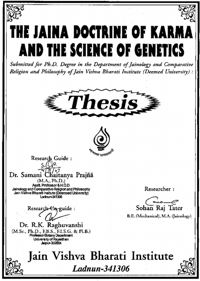Genes - the Life Motivator Component
We know that all beings without exception are assemblage of cells. We find that in all organisms, from the bacterium to man, the chemical machinery of all the cell is essentially the same in both its structure and functioning. Since Angles wrote the primary role of proteins in living processes, it has been further emphasized by the discovery that all these chemical reactions are catalyzed by enzymes which are themselves proteins. By means of 'instructions' embodied in the genetic material, DNA, according to the genetic code that is universal in that the DNA-RNA protein system or some variant of it, is operative in all living organisms. But the 'instructions' or information on the basis of which a new living being arises is always contained in the genome, the genes and chromosomes, of another structurally similar being, its parent(s). Description of functioning of a living organism may be recorded not merely on a paper, tape or punch card but also in the genetic material (DNA) of which genes and chromosomes are made. The real marvel is rather how this colossal information is locked in tiny DNA macro molecules, the genes.
Consider first the cell structure. All living beings, without exception, are made up of the same two principal classes of micro-molecules - protein and nucleic acids. The nucleotides of the nucleic acids on the same hand and amino acids of proteins, on the other. More importantly, these macro molecules are made up in all living beings by the assembly of the same residues, 20 L type amino acids for the proteins and nucleotides for nucleic acids. As for its functioning the same reactions or rather sequences of reactions we earlier called metabolic pathways are used in all organisms for the essential chemical operations, namely the mobilization and storing of chemical potential and the bio synthesis of cellular components.
If the new born infant is brought up in a jungle environment where there is no human language, he remains speechless for whole life. If during critical period of his development the environment provides no opportunity for the practice of knowledge, the individual never acquires the gift of speech. He remains a sort of speechless humanoid. Since the precise cortical organization of human cerebral cortex that enables him first learn to speak and thus armed to familiarize himself, with the world of objective knowledge depends greatly on appropriate neonatal environment, the old debate about the relative contribution of heredity (genes) and environment (nature) in making the mind of man.
It has been estimated that while the cerebral capacity of the gorilla brain is 1014 bits, that of human brain is 1015 bits. Assuming that 1014 bits is the minimum threshold for information required for self maintenance and reproduction of an organization as complex as a gorilla or man, there is in a man a vast reservoir (1015 - 1014) = 9 x 1014 bits of cerebral power available for this practice of language, science, technology, spirituality and other cultural pursuits. If thus happens that while only 10% of this cerebral capacity suffices to perform all the physiological functions of his animal existence, the remainder 90% enables him to become what he is, namely homo sapien - man the wise.[109]
 Prof. Dr. Sohan Raj Tater
Prof. Dr. Sohan Raj Tater
 Doctoral Thesis, JVBU
Doctoral Thesis, JVBU